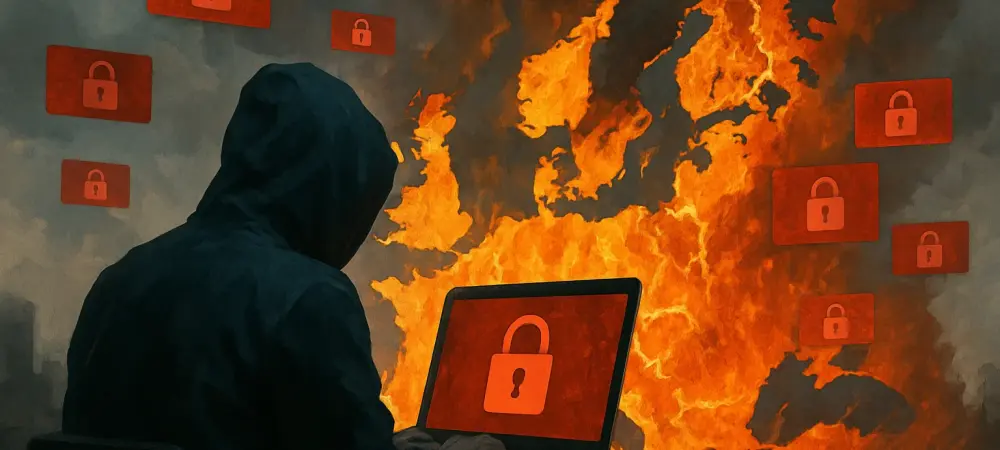A Growing Digital Battlefield: Setting the Stage for Analysis
In 2025, Europe stands at the forefront of a digital war, grappling with an unprecedented surge in ransomware and extortion attacks that threaten the stability of its economic and political landscape, with nearly 22% of global ransomware victims originating from this region. The stakes have never been higher for businesses and governments alike. This market analysis delves into the intricate web of factors driving Europe’s vulnerability, examining current trends, key data points, and future projections for cyber threats. By unpacking the economic, geopolitical, and technological forces at play, this exploration aims to provide a comprehensive understanding of why Europe remains a prime target for cybercriminals and what this means for the broader market.
Decoding the Cyber Threat Market: Trends and Insights
Economic Incentives: A Lucrative Playground for Ransomware Groups
Europe’s economic landscape serves as a magnet for ransomware operators, with high-revenue industries such as manufacturing, technology, and professional services offering substantial payouts through big-game hunting strategies. Groups like LockBit, Akira, and RansomHub have honed their focus on larger corporations, exploiting the financial capacity of these entities to demand hefty ransoms. The diversity of legal frameworks across European nations further amplifies this issue, as inconsistencies in cybersecurity regulations create exploitable gaps for cross-border criminal activities. This economic allure, combined with varying levels of enforcement, positions the region as a low-risk, high-reward arena for threat actors seeking to maximize profits.
Geopolitical Instabilities Fueling Digital Disruption
Beyond financial motivations, geopolitical tensions significantly shape the cyber threat market in Europe. Conflicts involving major global players have led to a sharp rise in state-sponsored and ideologically motivated attacks, targeting nations like the UK, Germany, and France. Since these tensions escalated in recent years, there has been a notable increase in denial-of-service attacks and hack-and-leak campaigns, often used as tools of digital warfare. A 13% year-over-year surge in dedicated leak site entries naming European organizations highlights how political unrest acts as a catalyst, blending traditional cybercrime with ideological agendas and complicating the threat landscape for regional markets.
Sectoral and Regional Hotspots: Mapping the Risk Zones
Certain sectors and regions within Europe face disproportionate risks, reflecting specific vulnerabilities in the market. Manufacturing, retail, and industrial engineering stand out as prime targets due to their critical role in supply chains and often outdated cybersecurity infrastructure. Countries such as Italy, Spain, and the UK bear a heavier burden of attacks, driven by their economic prominence and advanced digital ecosystems. This uneven distribution of cyber risks underscores the need for tailored defenses, as ransomware groups adapt their tactics to exploit sector-specific weaknesses, creating a fragmented yet highly targeted threat environment across the continent.
Future Projections: Emerging Threats and Market Shifts
Innovative Attack Vectors on the Horizon
Looking ahead, the cyber threat market in Europe is poised for further evolution with the emergence of sophisticated attack methods. Voice phishing, enhanced by artificial intelligence to mimic trusted voices, is expected to gain traction, posing a significant risk to unsuspecting organizations. Additionally, tactics like fake CAPTCHA lures and malware-as-a-service are becoming more prevalent, alongside violent real-world crimes such as cryptocurrency theft and kidnappings, with 17 incidents reported since the start of 2025, primarily in France. These hybrid threats signal a shift toward more dynamic and multifaceted strategies, challenging traditional cybersecurity models.
Speed and Agility: The New Cybercrime Benchmark
The operational tempo of ransomware groups is another critical factor shaping future market dynamics. Adversaries like Scattered Spider have reduced their time to deployment to a mere 24 hours, demonstrating an alarming level of agility that leaves little room for reactive defenses. This rapid pace of attack execution necessitates a fundamental shift in how European organizations approach cybersecurity, pushing for proactive measures and real-time threat intelligence. As cybercriminals continue to refine their speed and adaptability, the market will likely see increased pressure on businesses to invest in cutting-edge solutions to stay ahead of these accelerated threats.
Market Implications: Rising Costs and Strategic Responses
The escalating complexity of cyber threats is set to drive significant shifts in the European cybersecurity market over the coming years, from 2025 to 2027. The financial burden of ransomware attacks, coupled with the cost of implementing robust defenses, is expected to surge, impacting operational budgets across industries. Companies will need to prioritize investments in agentic AI for enhanced security operations, secure identity ecosystems to prevent unauthorized access, and strengthen cloud defenses as a core component of their infrastructure. These strategic responses will redefine market priorities, emphasizing resilience and innovation as key competitive advantages in an increasingly hostile digital landscape.
Reflecting on the Past: Lessons and Pathways Forward
Looking back on the developments of 2025, it became evident that Europe’s struggle with ransomware and extortion attacks had exposed deep-rooted vulnerabilities in its economic and digital frameworks. The convergence of geopolitical strife, economic incentives, and rapid technological advancements had created a perfect storm for cybercriminals to exploit. Moving forward, organizations needed to adopt a forward-thinking mindset, integrating comprehensive cybersecurity strategies to address both digital and physical threats. A focus on closing visibility gaps across domains emerged as a critical step, alongside fostering cross-border collaboration to harmonize legal and regulatory approaches. These actionable measures offered a pathway to mitigate past challenges, ensuring that lessons learned paved the way for a more secure and resilient digital future in Europe.

